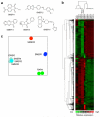Chemical genetics screen for enhancers of rapamycin identifies a specific inhibitor of an SCF family E3 ubiquitin ligase
- PMID: 20581845
- PMCID: PMC2902569
- DOI: 10.1038/nbt.1645
Chemical genetics screen for enhancers of rapamycin identifies a specific inhibitor of an SCF family E3 ubiquitin ligase
Abstract
The target of rapamycin (TOR) plays a central role in eukaryotic cell growth control. With prevalent hyperactivation of the mammalian TOR (mTOR) pathway in human cancers, strategies to enhance TOR pathway inhibition are needed. We used a yeast-based screen to identify small-molecule enhancers of rapamycin (SMERs) and discovered an inhibitor (SMER3) of the Skp1-Cullin-F-box (SCF)(Met30) ubiquitin ligase, a member of the SCF E3-ligase family, which regulates diverse cellular processes including transcription, cell-cycle control and immune response. We show here that SMER3 inhibits SCF(Met30) in vivo and in vitro, but not the closely related SCF(Cdc4). Furthermore, we demonstrate that SMER3 diminishes binding of the F-box subunit Met30 to the SCF core complex in vivo and show evidence for SMER3 directly binding to Met30. Our results show that there is no fundamental barrier to obtaining specific inhibitors to modulate function of individual SCF complexes.
Figures



Comment in
-
Inhibitors for E3 ubiquitin ligases.Nat Biotechnol. 2010 Jul;28(7):682-4. doi: 10.1038/nbt0710-682. Nat Biotechnol. 2010. PMID: 20622837 No abstract available.
References
-
- Wullschleger S, Loewith R, Hall MN. TOR signaling in growth and metabolism. Cell. 2006;124:471–484. - PubMed
-
- Bjornsti MA, Houghton PJ. The TOR pathway: a target for cancer therapy. Nat Rev Cancer. 2004;4:335–348. - PubMed
-
- Petroski MD, Deshaies RJ. Function and regulation of cullin-RING ubiquitin ligases. Nature reviews. 2005;6:9–20. - PubMed
-
- Easton JB, Houghton PJ. mTOR and cancer therapy. Oncogene. 2006;25:6436–6446. - PubMed
Publication types
MeSH terms
Substances
Associated data
- Actions
Grants and funding
LinkOut - more resources
Full Text Sources
Other Literature Sources
Molecular Biology Databases
Miscellaneous

